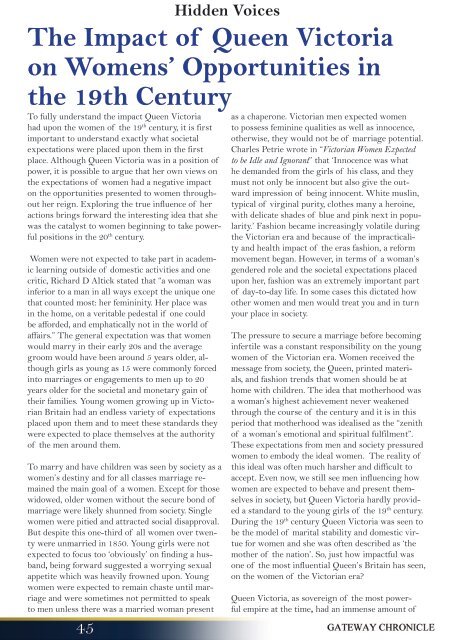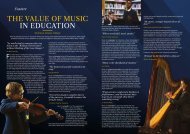You also want an ePaper? Increase the reach of your titles
YUMPU automatically turns print PDFs into web optimized ePapers that Google loves.
45<br />
Hidden Voices<br />
The Impact of Queen Victoria<br />
on Womens’ Opportunities in<br />
the 19th Century<br />
To fully understand the impact Queen Victoria<br />
had upon the women of the 19 th century, it is first<br />
important to understand exactly what societal<br />
expectations were placed upon them in the first<br />
place. Although Queen Victoria was in a position of<br />
power, it is possible to argue that her own views on<br />
the expectations of women had a negative impact<br />
on the opportunities presented to women throughout<br />
her reign. Exploring the true influence of her<br />
actions brings forward the interesting idea that she<br />
was the catalyst to women beginning to take powerful<br />
positions in the 20 th century.<br />
Women were not expected to take part in academic<br />
learning outside of domestic activities and one<br />
critic, Richard D Altick stated that “a woman was<br />
inferior to a man in all ways except the unique one<br />
that counted most: her femininity. Her place was<br />
in the home, on a veritable pedestal if one could<br />
be afforded, and emphatically not in the world of<br />
affairs.” The general expectation was that women<br />
would marry in their early 20s and the average<br />
groom would have been around 5 years older, although<br />
girls as young as 15 were commonly forced<br />
into marriages or engagements to men up to 20<br />
years older for the societal and monetary gain of<br />
their families. Young women growing up in Victorian<br />
Britain had an endless variety of expectations<br />
placed upon them and to meet these standards they<br />
were expected to place themselves at the authority<br />
of the men around them.<br />
To marry and have children was seen by society as a<br />
women’s destiny and for all classes marriage remained<br />
the main goal of a women. Except for those<br />
widowed, older women without the secure bond of<br />
marriage were likely shunned from society. Single<br />
women were pitied and attracted social disapproval.<br />
But despite this one-third of all women over twenty<br />
were unmarried in 1850. Young girls were not<br />
expected to focus too ‘obviously’ on finding a husband,<br />
being forward suggested a worrying sexual<br />
appetite which was heavily frowned upon. Young<br />
women were expected to remain chaste until marriage<br />
and were sometimes not permitted to speak<br />
to men unless there was a married woman present<br />
as a chaperone. Victorian men expected women<br />
to possess feminine qualities as well as innocence,<br />
otherwise, they would not be of marriage potential.<br />
Charles Petrie wrote in “Victorian Women Expected<br />
to be Idle and Ignorant” that ‘Innocence was what<br />
he demanded from the girls of his class, and they<br />
must not only be innocent but also give the outward<br />
impression of being innocent. White muslin,<br />
typical of virginal purity, clothes many a heroine,<br />
with delicate shades of blue and pink next in popularity.’<br />
Fashion became increasingly volatile during<br />
the Victorian era and because of the impracticality<br />
and health impact of the eras fashion, a reform<br />
movement began. However, in terms of a woman’s<br />
gendered role and the societal expectations placed<br />
upon her, fashion was an extremely important part<br />
of day-to-day life. In some cases this dictated how<br />
other women and men would treat you and in turn<br />
your place in society.<br />
The pressure to secure a marriage before becoming<br />
infertile was a constant responsibility on the young<br />
women of the Victorian era. Women received the<br />
message from society, the Queen, printed materials,<br />
and fashion trends that women should be at<br />
home with children. The idea that motherhood was<br />
a woman’s highest achievement never weakened<br />
through the course of the century and it is in this<br />
period that motherhood was idealised as the “zenith<br />
of a woman’s emotional and spiritual fulfilment”.<br />
These expectations from men and society pressured<br />
women to embody the ideal women. The reality of<br />
this ideal was often much harsher and difficult to<br />
accept. Even now, we still see men influencing how<br />
women are expected to behave and present themselves<br />
in society, but Queen Victoria hardly provided<br />
a standard to the young girls of the 19 th century.<br />
During the 19 th century Queen Victoria was seen to<br />
be the model of marital stability and domestic virtue<br />
for women and she was often described as ‘the<br />
mother of the nation’. So, just how impactful was<br />
one of the most influential Queen’s Britain has seen,<br />
on the women of the Victorian era?<br />
Queen Victoria, as sovereign of the most powerful<br />
empire at the time, had an immense amount of


















